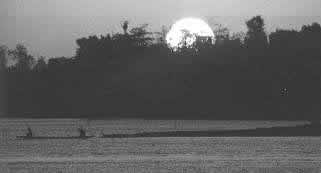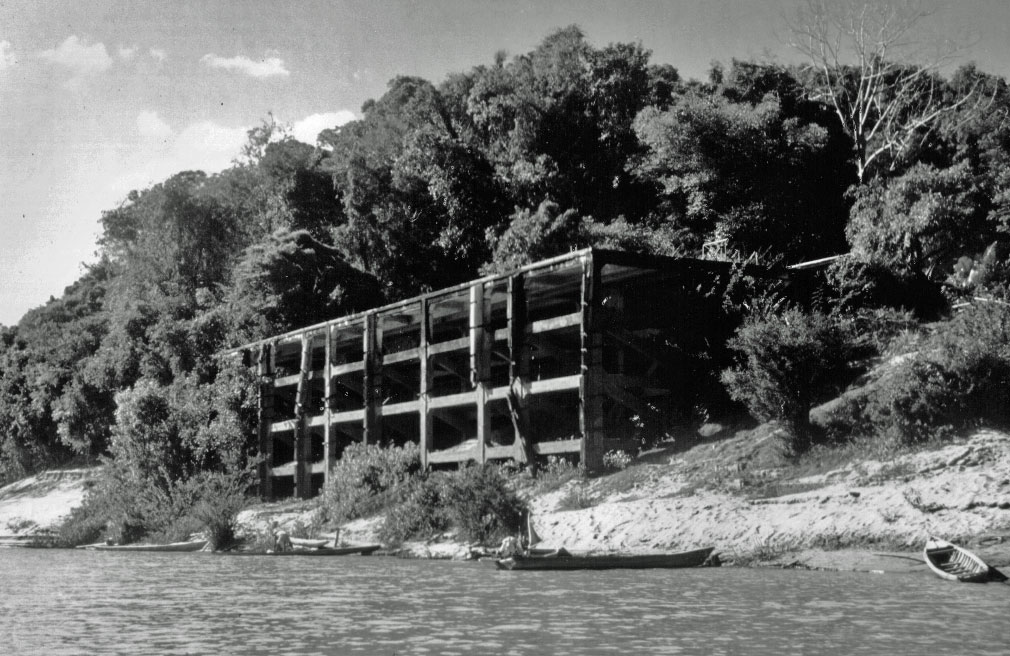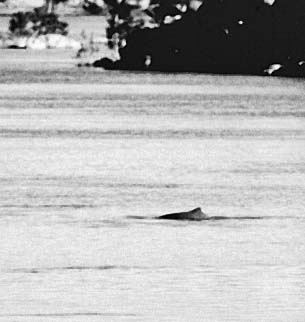Laos & Vietnam Paradise Where Dolphins InhabitDecember 1994
Mekong Development’in Laos?
The dolphins that inhabit in the Mekong River might die out before their existence was well known?this anxiety brought me to the southern part of Laos.
A Surge of Development

It has been very difficult to get access to this place until recently because of the Cold War between the East and the West and the closed-door policy of the Lao government, so that the incomparable beauty of nature in this place still remains as it was. But now, Mekong development is going to surge into this paradise, because the Lao government, which is in trouble over increasing debts, is hurrying up economic development, and in addition, international capital has started to invest in this country that is rich in natural resources and adjoins China and other countries of Indochina.
The Asian Development Bank (ADB), the United Nations Development Plan (UNDP), Japanese Official Development Assistance (ODA) and Global Infrastructure Fund Research Foundation Japan (GIF) initiate projects, and enterprises in Korea, Australia, Thailand and Norway get orders for construction work of the projects. But it is Japan that has participated in the making of the master plans since more than ten years ago and has provided most of the funds. Laos, the country in question, is in the shade because Laos has neither the know-how of development nor funds for it.
A Huge Resort
On the first day I visited a branch office of DAFI Travel in Pakxe to rent a car, and there I saw a conceptional drawing of the Khone Falls resort at its completion. The site is only a few kilometers away from the habitat of dolphins.
“We will start to construct a hotel in March finally,” said proudly an assistant manager, Somchai Patanamara (48) wasn’t on his guard against me at all. On the contrary he even showed me the blueprint. According to him, the area of the building site is 500 hectares. The resort will contain three hotels, a golf course and a casino. Besides, they will build folk villages of minor races so that tourists can see all of Laos. Moreover they will build a 29 MW hydroelectric power dam in the Mekong River to supply facilities in the resort with electricity and an international airport on Khong Island to receive tourists directly. The total cost of construction will be 380,000,000 dollars. Laos Holding Co. founded by Sonpot Piya Wi, a man of property in Thailand, will bear 70% of the cost and the Lao government will bear 30% by means of offering the land. Somchai also said the company would sell the management rights of the facilities to Japanese and Western companies.
“Do the dolphins also attract tourists, don’t they?” I asked him, trying to draw him out. “We have a plan to hire a trainer to train the dolphins for a show.” They are planning to give attraction shows in this place like ones given at an aquarium in a city.
A Boom in Dam Construction
Before going to see the dolphins, I visited one of the dam sites studding the southern part of Laos. The population of Laos is only 4,160,000. This country is mountainous and has no industry to speak of. Laos’s only source of foreign exchange is hydroelectricity and timber. 15 projects of dam construction in Attapeu Province were already approved. In the province a range of mountains about 1,500 meters high rises and forms a boundary between Laos and Vietnam. It is expected that 2,954 MW of hydroelectricity, about a third of 9,832 MW of all the power production in the country, will be generated at these dams of the Sekong water system, one of the tributaries of the Mekong River. The total cost to construct 17 dams including two dams that were already completed amounts to 510 billion yen odd.
Four years ago Seset Dam (45MW), the second biggest dam in this country, was constructed. Owing to the road construction for the dam, National Highway 20 leading to Attapeu was surprisingly good. Laos exports most of the electricity generated here to Thailand and gains five million dollars a year. Hensawan (28), an engineer of the dam, said, “The village is now served with electricity, so the villagers can extend their fields by using an electric pump. They can work at night too. So, their income has increased.” According to him, the locals are also receiving benefit from the dam.
A Dutch tourist Sandra (32), who was reading a book by a little stream, said, “The people are kind; nature is beautiful. Laos is wonderful. A group tour may not be so easy because of lacking traffic facilities, but easy access is a double-edged sword. I hope that this country will not be ‘a second Thailand’.”
As soon as I passed Seset, the road became so bumpy that even my four-wheeled vehicle jolted horribly. I heard a chain saw roaring. I stopped my car. “It’s falling!” I saw a dozen of workers cutting trees together and a tractor hauling fallen trees to the road. “We got orders to cut trees on the area 20 meters broad from both sides of the street,” said one of the workers. Construction work to widen a national road is being carried out in advance of the construction of a dam. A worker, who was a farmer three years ago, said with a smile, “I can earn much more money than before. I built a new house.” “But this work will last only for a few more years till Laos is developed.” Deforestation is proceeding at so furious pace that all trees seems to be cut down in such a short time. He said that when the time comes, he would go back to farming. But I’m afraid that this country may be suffering from repeated floods and droughts at that time like Thailand is suffering now.
I visited the site of the first Sekaman Dam that will be constructed prior to all other projected dams. Part of the road was the former Ho Chi Min Trail. There was a decayed Soviet-made antiaircraft missile more than 10m long on a launching pad in the forest. When the missile was being transported, the Vietnam War ended, so it was given up and left there. The jungle road that was once used to send supporting goods to the Vietcong is now used to transport building materials to the dam site. The forest dense with big trees more than 50m long suddenly ended and a V-shaped valley with the rapids appeared. It was a dam site. A wire rope tied to a bolt driven in a thick trunk of a tree on the riverside was stretched to the other side. A flow meter was fixed to it. Three villages within five kilometers up the river will be submerged. Buntai (36) of the economic development section of Attapeu Province hesitatingly said about the compensation, “The details including who will pay and where the villagers should move haven’t decided yet.
A Hangover From The French Rule

Like other fish do, the dolphins reportedly migrate to the tributaries in Attapeu Province in the rainy season, when the quantity of water increases. But it’s the dry season. I headed for Hang Khone Village where the dolphins gather. The village, located 180 kilometers to the south of Pakxe, was on an island three kilometers long and one kilometer wide in the Mekong River. Just the opposite shore is Cambodia.
Our small boat bound for the village passed a beacon, which is out of place. The boatman said, “I heard that big steamships used to navigate here.” A darkish concrete structure stands beside the ferry. It was a pier where cargo ships of about 300 tons arrived and departed half a century ago. In the days of the French rule, teak trees under shipment were landed for a while, because on route to the South China Sea there was a waterfall that a ship couldn’t pass through, so they were conveyed by train on the island and then they were loaded on a ship again at this village down the river from the waterfall. When I went on the island, I found a rusted boiler of a steam locomotive covered with weeds. Although industrial civilization was transplanted, it didn’t take root in this village.
A Legend That Has Come Down In The Village
Not only in Hang Khone Village but also in its neighborhood, either water or electricity is not supplied. Needless to say, there are no services of telephone and gas. Except a boat with an engine, the vehicles in the village are only bicycles and ox wagons. Since there is no hotel in this village, Punpen Pirawat (29), an official of the Ministry of Agriculture and Forest, let me stay at his own house. He is working on “the project for the preservation of forest and dolphins”.
There is a deep pool called “Boonpagoan” in front of the village and the flow of water is slow. In the dry season, when there is a small quantity of water, the dolphins inhabit in this deep pool of one-kilometer square. I lost no time in going dolphin-watching by his boat. Trees and craggy mountains that go under water during the rainy season just look like ones in a miniature garden. We moored the boat in the shade of a rock and have waited for an hour. But a dolphin hasn’t appeared.
The dolphins are called “Paloma” in Vientiane the same as in Thailand under the influence of television, but they are called “Paa Khaa” in here. With my eyes fixed on the surface of the river, I inclined my ears to the legend of Paa Khaa that had come down in the village. “Once upon a time, a married couple was going down the Mekong River on a raft, pursuing happiness. When they were approaching the Li Phi Falls, chickens and monkeys that were also on a raft made a danger call but the couple didn’t understand it. The Li Phi Falls actually exist above the village. Since the scenery with a weir is on a postcard, the falls are getting famous. “The couple fell down into the basin of the waterfall and died, but they were reborn; the husband became a ‘Paa Khaa’ and the wife became a white bird called ‘Shida’. So when Shida calls, flying above the river, Paa Khaa always appears.”
“It’s Paa Khaa!”

Just when we almost abandoned this place and moved to another place, Shida started circling above our small boat. Then came a sound “Pushoo!”
It was the sound of Paa Khaa breathing. Animal’s odor such as we smelled in a zoo assailed my nose. “Look, there!” Bunpen pointed out the surface, which was smooth because of the junction line between two currents. But it was too late. The Paa Khaa inhaled the fresh air and went into water. But when it appeared a second time, I saw it too. It happened just as the legend said. I felt as if I was bewitched by a fox.
Paa Khaa doesn’t jump like sea dolphins. They come up close to the surface for a second or two every 5 to 20 minutes, but they show only their backs. When they chase fish or woo, they show themselves more. Some Paa Khaa swim alone; some with their child; some in a group of more than three. Unlike the Ganges dolphin or the Yangtze dolphin, both of which are freshwater dolphin same as Paa Khaa, Paa Khaa’s beak doesn’t stick out and its fins aren’t atrophied. It rather looks like a pilot whale in the sea and its big body is nearly three meters long. According to Bunpen, about 100 dolphins inhabit here now and their home range in the dry season is from Boonpagoan to about 10 km down. That is, the dolphins move to and from Cambodian territory.
Preservation Project
I sat down at the dinner table with Bunpen. River fish and glutinous rice were served. “Fishing is banned December through April in Boonpagoan, because it is the spawning season. The village made this rule two years ago and everyone has observed it. If a dolphin is caught in a fixed net, we cut the net and let it free.” A Canadian NGO will help to make up for a damaged net, but no dolphin has been caught in a net.
With the corporation of the whole village of 52 families, Bunpen keeps a tally of the number, sizes and kinds of fish that the villagers caught for a day. There are more than 100 kinds of fish in this area including scarce kinds. In rainy season the water level of the Mekong River rises by nearly 10 meters and the forest goes under the water, which will be a likely place for fish to live. But if many dams are built as planned and the water level is controlled artificially, there will be no such a natural cradle.
Harmony With Life
A fisherman Numai (34), who was checking bamboo fish traps similar to a rattrap, complained that he had gotten a remarkably small catch of fish recently. “Until my father’s day, they had caught fish enough for them to eat with a tool like this. But now everyone overfishes with a nylon net to make a living.” He cautioned himself. But he needs at least 20,000 kip (about 2,860 yen) a month to raise six children. “I spend most of the money on rice, but I sometimes have to buy salt, red pepper and clothes…” Although it has been two years since the preservation project started, no other fishermen said they caught as many fish as before. Numai said Cambodia was to blame for the sharp decrease in the number of fish. “In Cambodia they catch fish by giving an electric shock or exploding a mine in the water. Surely they can catch a lot of fish at a time, but fry and dolphins are also killed at the same time. Fish in this area come and go between here and Thonle Sap Lake in Cambodia.
A photo of a dolphin that was killed by a blast fishing method was printed in Thai newspaper at the end of March last year. This method is prohibited in Laos. If someone uses this method, he will be put in jail. Bunpen started to encourage the villagers to raise chickens and pigs and grow vegetables in the village to make a living without depending entirely on fishing.
For The Sake of The Country
I visited Tako Village, whose people are forced to leave due to the development of resort in question. “I approve it, if it is for the sake of the country.” The old men who were hanging around the restaurant were proud of patriotism. Girls who were enjoying playing badminton at a vacant lot said nonchalantly, “I want our village to be served with electricity. I want to watch TV.” It is very difficult to imagine these unsophisticated girls playing golf or gambling games in a casino.
Also I don’t think the villagers can work in a service industry where they have to work for foreign tourists. Tourists demand as good services as they can get in a city, even though they come here to find pleasure in nature.
The River Where Dolphins Can Survive
The dolphins are at the top of the food chain in this Mekong River system. The equivalents to the dolphins in the neighbor forests are Malayan tigers, the number of which is estimated to be about 200, and very rare Java rhinos, the number of which has already decreased to only a dozen. In 1987 the forest rate was 47 %, but now it is estimated to be below 30 %. These big animals are the first to be extinct.
I asked the villagers why they are devoted to protecting dolphins. They have no conception of ecosystem. They said with fondness, “The dolphins help us by driving fish to a net,” or “They save people from drowning.” But the villagers must be worried about big changes in the Mekong River. They all voluntarily refrain from overfishing despite a decrease in their income. If the dolphins can survive in the Mekong River, the villagers who depend on the river will also survive.
When I parted from Bunpen, he said in a low voice, “I think the development of the Khone resort will end up with the same result as that railway, because the facilities are for foreigners.”
Unimaginable Future
The assumption that nature in here would be destroyed in exchange for development never went down with the people in any villages. As the interpreter suggested me that they would not understand the meaning of the assumption, the villagers were at a loss for words. But their expression indicated that they were not perplexed because of pressure from the authority. They just couldn’t imagine a river where fish and dolphins could not live and whose water was not drinkable. They think it strange that foreign tourists are moved by nature.
Although the purge of socialism has become a past event, I don’t think the administration of this country doesn’t function democratically. Does massive-scale development exceed in the development of village people in this country?
I left Laos for Ubon Ratchathani in Thailand. I drove a car northeast along the Sirindhorn Dam, which was named after a princess of Thailand. Many farmers in the northeast region of Thailand go to Bangkok to work. I heard that Paa Khaa could be seen even in Bangkok long time ago. My car is running on a smooth asphalt road, with the speedometer indicating 100 km per hour. A surge of development is approaching to the paradise in Laos, increasing its speed.

